Humba Recipe
Humba is a dish of tender pork, salted black beans, and an assortment of spices. With its deep flavor palate and numerous ingredients, it is the perfect combination of sweet and savory –– two such flavors that Filipinos adore. Chinese-Filipino cuisine has been a part of our culture for decades. Since pre-colonial times when traders…
This post may contain affiliate links. Please read our disclosure policy.
Humba is a dish of tender pork, salted black beans, and an assortment of spices. With its deep flavor palate and numerous ingredients, it is the perfect combination of sweet and savory –– two such flavors that Filipinos adore.
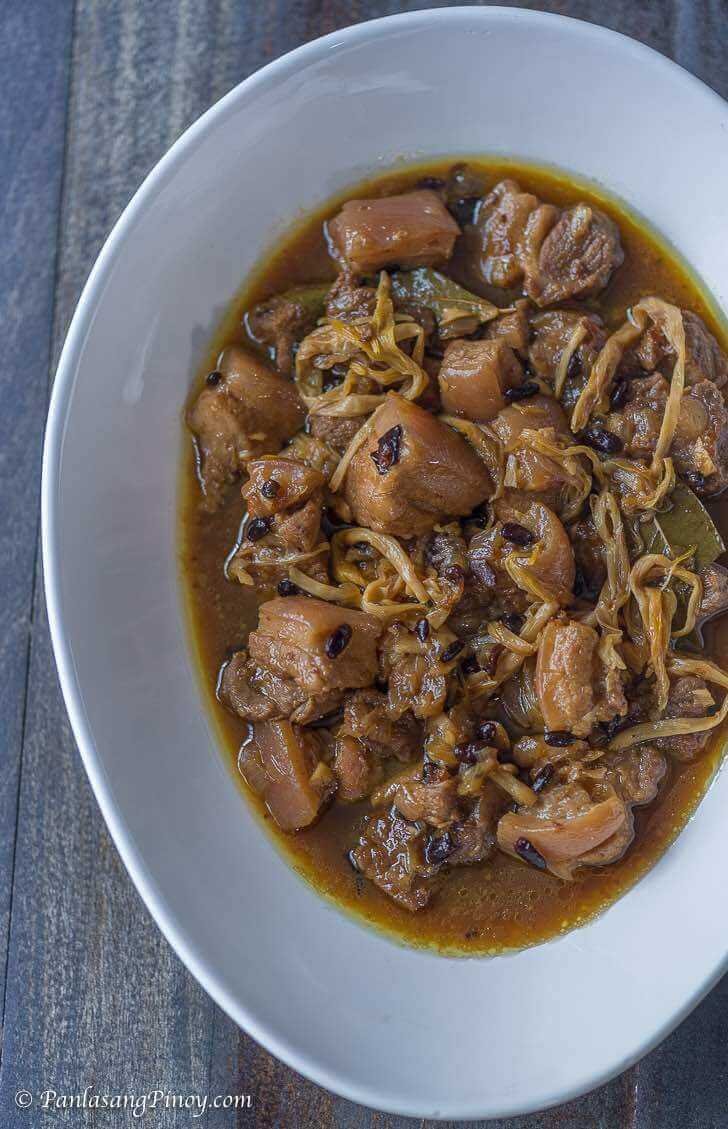
Chinese-Filipino cuisine has been a part of our culture for decades. Since pre-colonial times when traders used to dock on our shores, the Chinese have shared with us not only their barter and bargaining practices, but also their cooking. Dishes like pancit, lumpia, and mami are some examples of traditional Chinese dishes that have been given a Filipino spin. Humba is yet another example of Chinese cuisine’s integration into Filipno culture. Initially, this pork dish was actually based off of the Chinese hong ma or hong ba –– red braised pork belly.
But looking at the humba we know now, it’s clear that over time this dish has evolved. The meal we’re more familiar with today bears a closer resemblance to adobo than the braised pork belly it loosely borrows its name from. Some even refer to humba as a Visayan version of adobo –– one of our contenders for national dish! One of the main differences, however, is the cooking process of these two meals. Where you simply toss together all of adobo’s ingredients and let it simmer and marinate, in humba the pork is braised, fat rendered, and then left to simmer in the different spices.
The addition of other ingredients like bananas and beans also make humba’s taste stand out from adobo’s. While the latter leans more into the umami taste, the former is able to strike a balance between salty and sweet. The only thing you’ll be worrying about is how much rice you’re going to be needing!
Pork Humba Ingredients
As we mentioned earlier, pork humba has taken the original Chinese red braised pork belly and given it a Filipino spin. This includes taking out some of the original ingredients, like shaoxing wine or five spice powder. In lieu of these, we’ve used ingredients like vinegar, bananas, sugar, and pineapple juice to make up humba’s distinct taste. These are also easier to find locally, making it quick and simpler for anyone to find in supermarkets so they can make humba from the comforts of their own home.
Here are other variations or twists you can put on your humba according to your preference:
Bananas for bananas
This recipe of humba includes the purple, flowery banana blossom. Many cuisines in East Asia and India have begun to incorporate this ingredient in their cooking. Banana blossom is popular amongst those with vegan diets; its texture and adaptable taste make it a fantastic meat substitute. In vegan supermarkets, dishes like ribs and even adobo contain banana blossoms instead of the typical meat or chicken.
While humba is still humba without its presence, this additional ingredient gives a complex and more interesting layer of flavor to your dish. You can also add artichoke as a fairly acceptable substitute. However, I do recommend having banana blossoms in your humba dish –- it will definitely end up a lot tastier.
Star anise: the star of the show
Some of the spices that grace a plate of humba include onions, garlic, bay leaves and peppercorn. Another optional ingredient in humba is this small, star-shaped spice you can find in several Asian dishes. Star anise is one of the main ingredients of Chinese five-spice powder –– an original ingredient in the Chinese braised belly dish we mentioned prior. Star anise is a wonderful addition that can enhance your dish’s flavor palate. Although it’s small, its presence works wonders; it may not be the start of the show, but it definitely helps to highlight it!
Star anise’s enticing aroma and taste make it a fantastic addition to pork humba. However, it’s important to remember that while you’re putting the spice in whole, I’d refrain from eating it whole, too –– it can be quite overwhelming on the tongue!
A refreshing zing
Like adobo, humba’s base sauce consists of a mix of soy sauce, vinegar, and water. These liquids are combined and incorporated together to braise the meat later on, making for an absolutely mouthwatering marinade.
But another ingredient for this combination is the refreshingly sweet pineapple juice! This delightful drink isn’t something you’d think to find in so savory a dish like humba, but that’s what truly sets it apart. The pineapple juice helps balance out the acidity of the soy sauce and vinegar, as well as acts as an additional sweetener for this dish. The splash of zest pineapple juice can offer is just what your humba needs! But if you don’t have any onhand, I also recommend sodas like Sprite or 7-Up.
Meet your meat! (… or not?)
Humba’s main protein is commonly pork; the pork belly, to be more specific. There are very few things quite as satisfying as the lean, succulent feel of pork belly in your mouth. It’s also great for soaking up the delectable flavors humba has to offer. Other parts of the pork we often use in humba include pork legs, hocks, and sometimes even the shoulders. Additionally, other renditions of humba use chicken as a viable, and slightly healthier, substitute for this meat.
But if you are planning to go the meat-free, vegetarian, or vegan route, don’t worry! You don’t have to forsake the phenomenal taste of humba for your health. In fact, it’s incredibly easy to make a plan-based version of humba! All you need to do is substitute the pork you’re using with tofu. Most of the original ingredients of humba are already all natural; there’s no need for you to substitute them! This works in your favor as you’d want to retain the fantastic taste of this dish. Tofu humba is a prime example of how you need not sacrifice your health for a wonderful meal!
How to Cook Humba
One important aspect of cooking humba is time. Making this dish is quite simple, but it also takes time –– about an hour or so, to be specific. A lot of this time goes into waiting. We’re braising and cooking pork at a low heat, in order to render the fat more thoroughly. If you plan to marinate your pork early on, try to keep it within a time frame of 30 minutes to 8 hours, maximum. Any longer and the acidic vinegar and pineapple juice may break down some compounds in your pork.
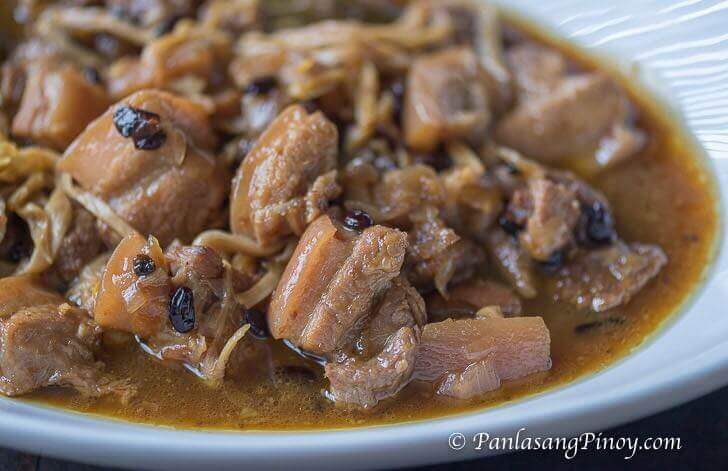
Let’s prepare the ingredients for your humba! Dice one large onion and mince 5 cloves of garlic. You will also need these other following ingredients:
- Pork belly
- Pineapple juice
- Salted black beans
- Soy sauce
- Vinegar
- Banana blossoms
- Dried bay leaves
- Peppercorn
- Brown sugar (alternatively, you can use palm sugar –– just not white! Brown sugar has a less emphatic sweetness, and also operates as a natural thickener for your sauce)
Cook pork humba with me! In a hot cooking pot, toss in your pork belly and let it cook until it browns. Add in the onion and garlic slices you have and cook, until your onions soften. Then, add in your 2 tablespoons of soy sauce, peppercorn, and bay leaves.
Next, pour in 1 cup of pineapple juice and bring your humba to a boil. Cover the pan and let your dish simmer until your pork becomes tender. If you feel like it’s getting a little too dry for your taste, feel free to add water in as well. This should take about 30 to 40 minutes.
When that time has passed, add in 2 tablespoons of vinegar and wait for your mixture to re-boil. Let your dish simmer for about 3 minutes, then spoon in the salted black beans. Add in your brown sugar as well, then give your humba 5 minutes more. Lastly, take your dried banana blossoms and toss them into the pot. Cook all of your humba ingredients together for the last 5 to 8 minutes.
Turn the heat off the stove and transfer your pork humba to a serving plate. Serve this dish with copious amounts of rice; it’s bound to be a hit! Share and enjoy it with the rest of your family today!
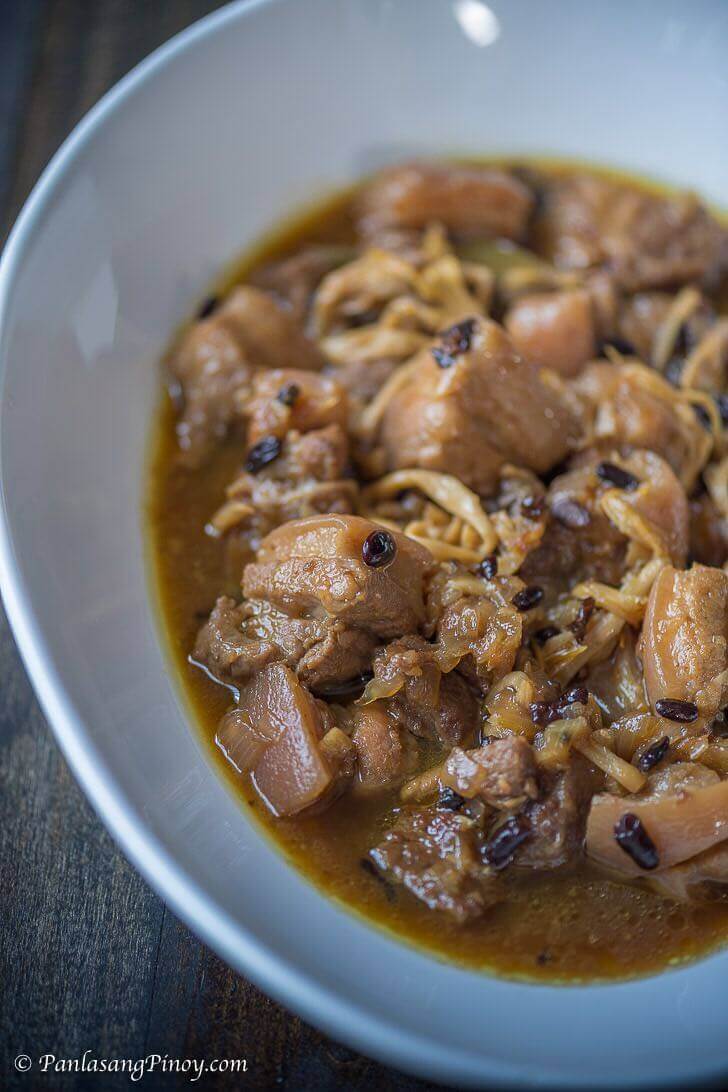
Related Recipes
If you enjoyed this awesome dish, here are some other recipes you can try at home, too!
Asado is another staple of many Filipino-Chinese restaurants. Like humba, it makes use of star anise and other similar elements, like five spice powder. Slabs of meat are left to simmer and absorb a combination of several spices in order to create a dish that is enticing and filling. The marriage of all these different spices –– cloves, cinnamon, Sichuan pepper, and fennel –– make it a dish that is truly remarkable. I enjoy this dish with a nice, steaming bowl of rice, and fresh greens like bok choy.
Pork Adobo in Pineapple Juice with Boiled Egg
Pineapple juice is once again utilized, this time in a classic Filipino dish! Pineapple juice, as we mentioned earlier, helps plenty in tenderizing meat before cooking. By marinating your juicy pork in this liquid, you get meat that practically falls apart at the touch. The combination of succulent pork and warm, comforting boiled egg never fails, either! It’s very hard to go wrong with a dish like this one.
A sweet-smelling and sweet-tasting stew, estofado is a milder version of dishes like humba and adobo. This dish makes use of ingredients like saba banana and carrots to add to its depth of flavor. Like humba, most of the cooking time of this dish is spent waiting for the meat to tenderize. However, the end product is always worth it; I can guarantee you your family will go crazy for this amazing dish!
Did you like this humba recipe? Let us know what you think!
Did you make this? If you snap a photo, please be sure tag us on Instagram at @panlasangpinoy or hashtag #panlasangpinoy so we can see your creations!

Humba Recipe
Ingredients
- 2 lbs pork belly
- 1 cup Pineapple juice
- 1 large onion diced
- 5 cloves garlic minced
- 2 tablespoons salted black beans
- 2 tablespoons soy sauce
- 2 tablespoons vinegar
- 2 ½ tablespoons brown sugar
- ½ cup dried banana blossoms
- 2 pieces dried bay leaves
- 1 teaspoon whole peppercorn
Instructions
- Heat the cooking pot then brown the pork belly
- Add the onions and garlic and cook until the onions are soft
- Put-in the soy sauce, peppercorn, bay leaves
- Pour-in the pineapple juice and let boil. Simmer until the pork is tender (add water as needed)
- Add the vinegar and wait for the mixture to re-boil. Simmer for 3 minutes
- Spoon-in the salted black beans and brown sugar then simmer for 5 minutes
- Add the dried banana blossoms and simmer for 5 to 8 minutes
- Transfer to a serving plate and serve. Share and enjoy!
Nutrition Information
How to cook it

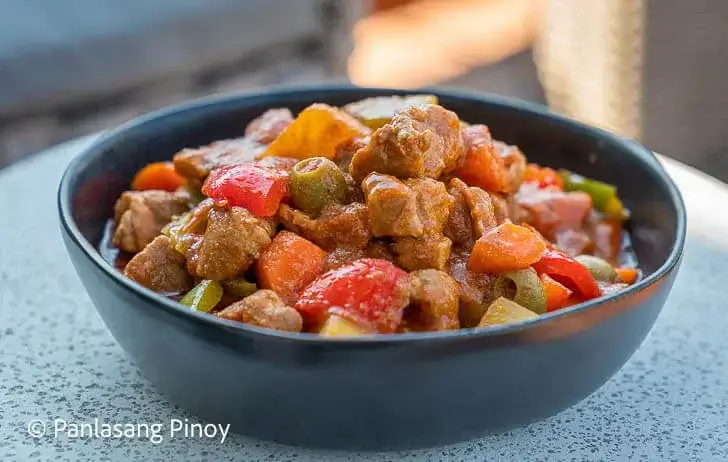
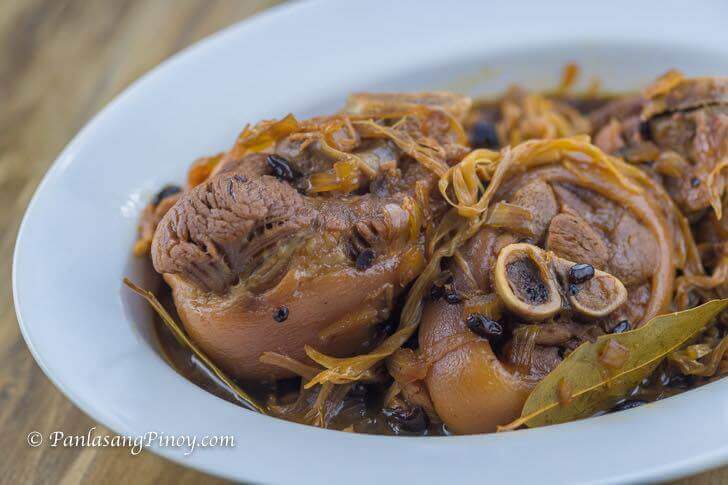
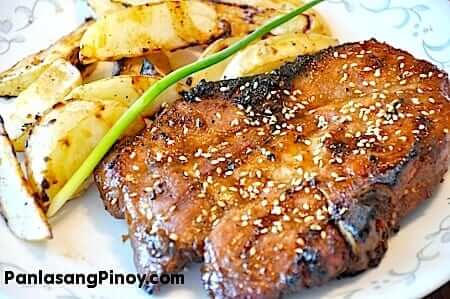
Ryan says
it looks delicious and after reading the procedures and the recipe I planned to cook it for lunch. Thanks for sharing 😀
katherine nolledo says
this site helps me a lot for my assignment..
thanks for the recipe.. and
now i can cook it for my father…
my favorite HUMBA..
Shiela says
Hi mr.vanjo, i want 2 share s0mething, here in pampanga we use dog’s meat, coconut, sugar as well, chili, star anis, and sweet potato the way we c0ok humba..
royski says
not all people can eat Dog meat, personally I don’t want to even try it.
Chyn says
I cooked this instead of beef caldereta since i cant find liver paste here in Elgin, Illinois…would you know where i can get those? Hope this humba works…
jack says
Banana blossom is optional. It will still be humba without that. However it will be a lesser humba compared one that has the banana blossom. It would still be delicious though.
joni-rose says
nice dish! thanks for making it easy for us to understand the instructions!
JL says
Hello! I only have soy bean paste, can I use soy bean paste as a substitute to salted black beans? Thanks in advance.